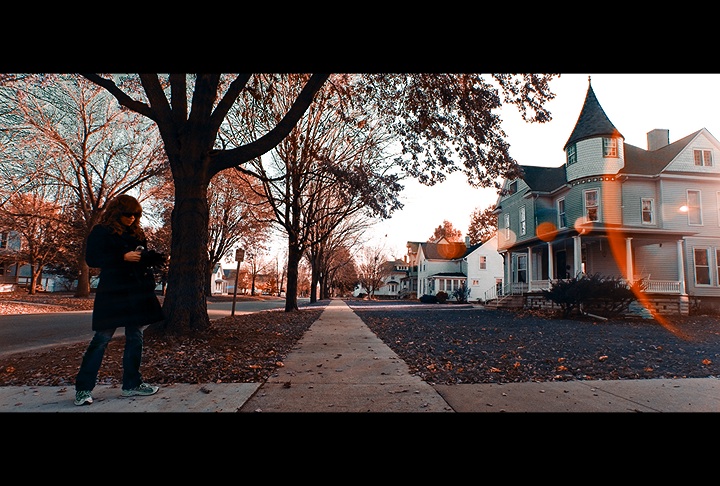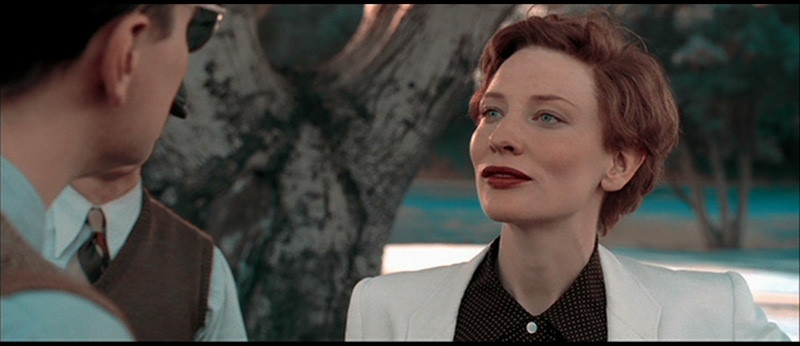Man har bruge en teknik der hedder "technicolor-2-strip-3-strip".
http://hassanvfx.blogspot.com/2007/11/technicolor-2-strip-3-strip.html
http://www.theasc.com/magazine/jan05/aviator/page3.html
"How did the idea for The Aviator’s color palette come about?
Richardson:
Prior to my involvement, Marty designed a color timeline that
influenced every creative department. He wanted the progression from a
two-color palette to a three-strip palette to approximate the
technological advances of the film industry at that time, but more
importantly, he felt it would mirror the characters’ emotional
evolution. The first act, which covers Hughes’s early career in
Hollywood, was supposed to have Technicolor’s two-color look. With the
second act, which begins after Hughes sets a speed record flying across
the continental United States [in 1937] and goes with Katharine Hepburn
to Connecticut, we transition to that vibrant, three-strip look that
most of us associate with the glorious Technicolor years. Then, when
Hughes almost dies crashing the XF-11, we were going to cut into a more
contemporary look without either Technicolor process applied.
Rob Legato: That
seemed like the right moment to [switch out of three-color], because
Hughes’s life changed dramatically after that crash — he started to get
very ill, and his looks changed. It’s definitely the darker side. But
when we were going through the film with Marty in the digital suite and
that transition happened, he said, ‘I kind of miss the color.’ So we
turned [the three-strip look] back on to show him what it would look
like, and he loved it. So now the rest of the movie has that look.
Richardson: Although
three-strip was extended into the final moments of the picture, the
costume and makeup [that accompanied that look] were not. The results
are sequences that blend a contemporary feel with some of the rich skin
tones we commonly associate with three-strip Technicolor.
Legato: I think it works well. One of the things I like about [Scorsese’s 1977 musical] New York, New York
is that Marty re-created that romantic [post-war] period but peopled it
with darker characters acting in a contemporary way. He seems to like
that counterplay. The last part of The Aviator has a lush, 1940s Technicolor look, but we’re seeing a story that’s suddenly much less ‘storybook.’
How did you create these looks? Did you plan on using LUTs from the beginning, or did you try other methods?
Richardson:
My first meeting with Marty didn’t foretell all of these complications.
He knew there were going to be blocks of two-color and three-strip, but
it wasn’t until later that we started to work out how we’d actually
achieve them. In fact, neither of us knew whether what he wanted would
actually be possible to put on film. When I started two months of
preproduction in May 2003, Dante had already built palettes for the
film as though it would be shot normally. As we started discovering how
we would achieve these transitions, he had to go back and alter his
color palette to allow for the enhancement of colors that would come
out in the Technicolor look. It was complicated and retroactive, and to
some extent it might have been more successful if we’d had more time
for prep.".
 technicolor-2
technicolor-2-
strip.
Og her et par screenshots fra Aviator taget fra DVD udgaven, hvor man kan se technicolor-2-strip.
Kilde: www.dvdbeaver.com


Så der er en logisk forklaring på de mystisk farver i Aviator.
Redigeret af Startrek - 29-December-2009 kl. 16:57


